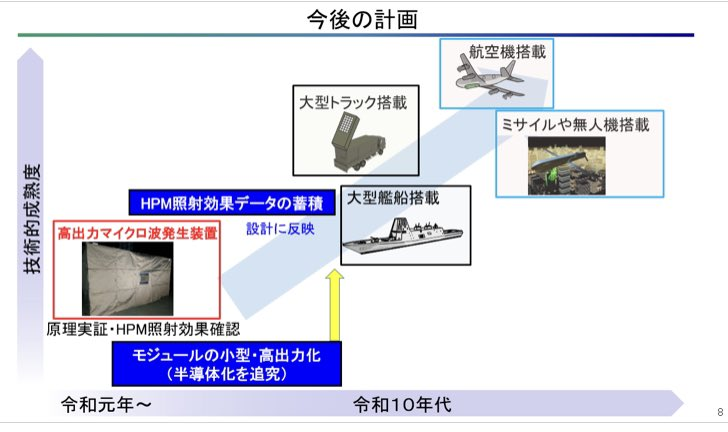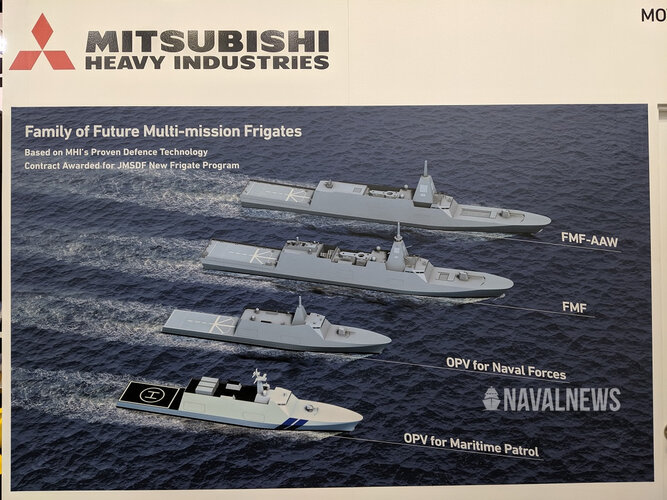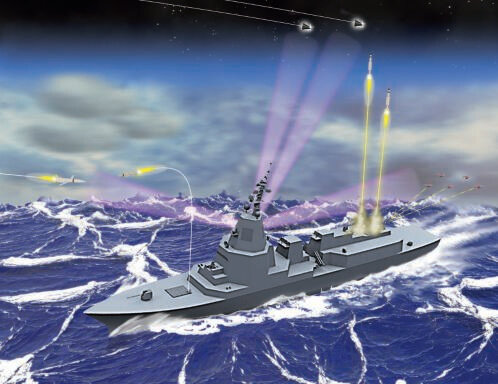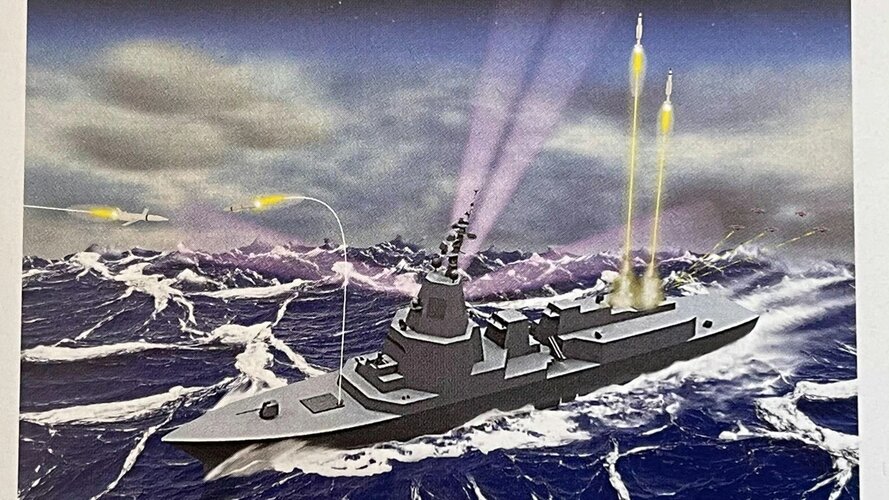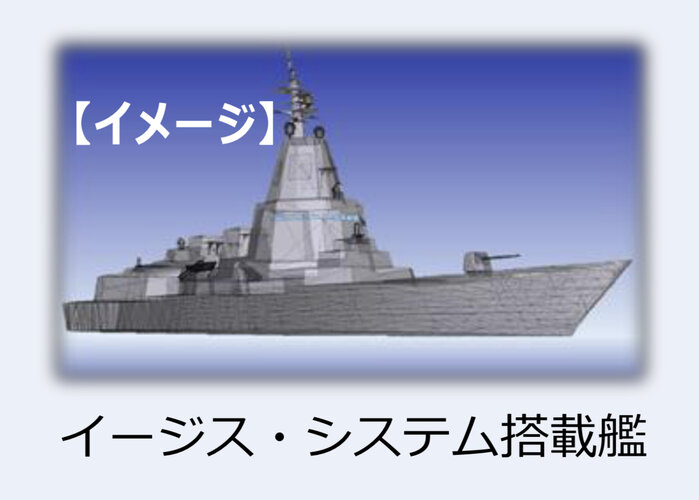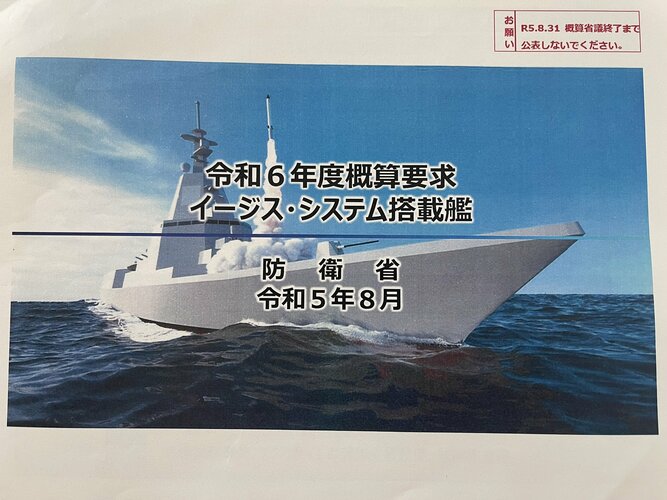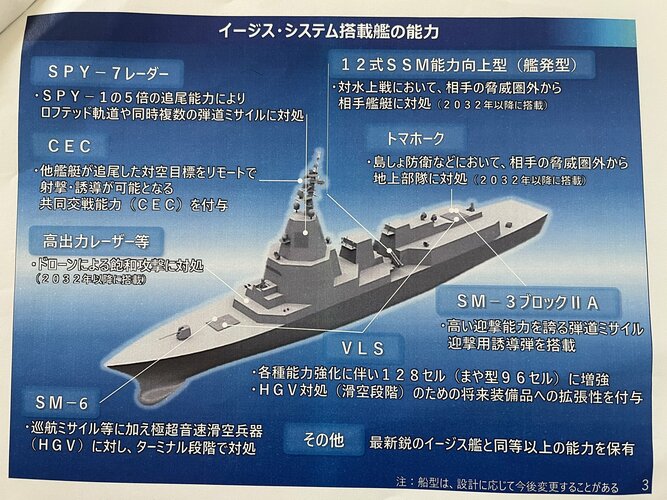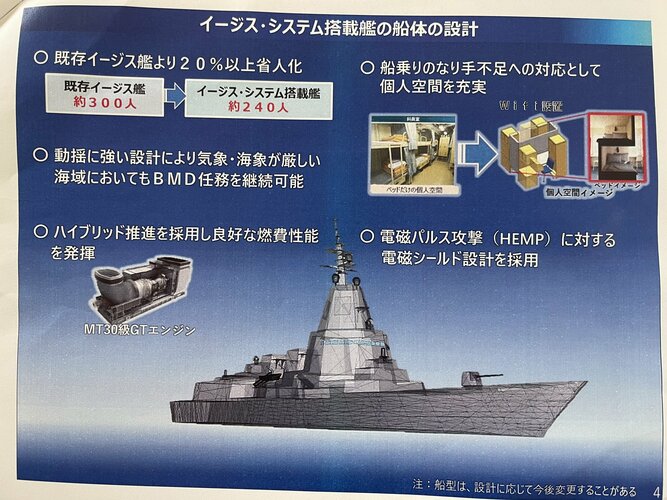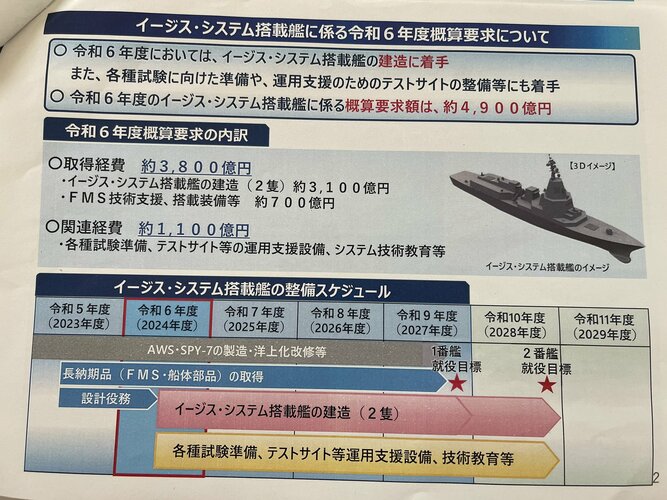I don't think nuclear reactors are an issue for Japan since MHI is one of the world leaders in small scale reactors. MHI already modified the RV Mirai to be nuclear propulsion. On the contrary I think the JMSDF really want it to be nuke prop for the added time out at sea. The ship is already going to have full individual quarters for every sailor, the name of the game appears to be long term deployments.I cannot imagine the JMSDF even considering nuclear propulsion for this. Even disregarding the domestic politics, the timelines make it an impossible option. There is no available nuclear reactor available to Japan.
The possible inclusion of the Type 12 missiles to me signals that these ships will have excess volume due to seakeeping requirements and they see an opportunity to get the improved Type 12 to sea without typing up their main fleet units.
You are using an out of date browser. It may not display this or other websites correctly.
You should upgrade or use an alternative browser.
You should upgrade or use an alternative browser.
Japan 20000t SPY-7 guided missile destroyer/cruiser
- Thread starter Kota
- Start date
- Joined
- 9 October 2009
- Messages
- 21,979
- Reaction score
- 13,647
Also, the MRX maritime reactor design shouldn't be that hard to revive as a starting point?
Here's a paper on it from the late 1990s:
(Also added as an attachment in case the link goes dead.)
Here's a paper on it from the late 1990s:
(Also added as an attachment in case the link goes dead.)
Attachments
- Joined
- 9 October 2009
- Messages
- 21,979
- Reaction score
- 13,647
That is indeed possible.The possible inclusion of the Type 12 missiles to me signals that these ships will have excess volume due to seakeeping requirements and they see an opportunity to get the improved Type 12 to sea without typing up their main fleet units.
- Joined
- 16 April 2008
- Messages
- 9,616
- Reaction score
- 14,524
Also, the MRX maritime reactor design shouldn't be that hard to revive as a starting point?
That's a 25-year old design. They can't revive that, build and test a prototype, and hope to hit that 2028 target date for the ship. How many of the people involved are even working in nuclear power anymore?
I don't think nuclear reactors are an issue for Japan since MHI is one of the world leaders in small scale reactors. MHI already modified the RV Mirai to be nuclear propulsion.
Japan's history with maritime reactors isn't robust. Mutsu (aka RV Mirai) was launched in the late 1960s, had a radiation event in 1974, within days of going critical, and spend another 17 years being cleaned up, modified, and overhauled. Then she spent a grand total of approximately 1year at sea before being decommissioned, having her reactor torn out, and being rebuilt as a conventional research vessel. This does not equate to a sufficient base of experience to field nuclear power in an operational warship within the next 5-6 years. Not in a country with as much anxiety about nuclear power as Japan has, especially after Fukushima.
The point is that Japan has experience with marine nuclear reactors which is more than most nations looking to do so can say. MHI also never stopped researching reactors and their current next project includes reactors that can be put in ships. Combine that with the fact that the US would be more than willing to offer support on maritime reactors for Japan if needed, but MHIs experience should be more than enough.Also, the MRX maritime reactor design shouldn't be that hard to revive as a starting point?
That's a 25-year old design. They can't revive that, build and test a prototype, and hope to hit that 2028 target date for the ship. How many of the people involved are even working in nuclear power anymore?
I don't think nuclear reactors are an issue for Japan since MHI is one of the world leaders in small scale reactors. MHI already modified the RV Mirai to be nuclear propulsion.
Japan's history with maritime reactors isn't robust. Mutsu (aka RV Mirai) was launched in the late 1960s, had a radiation event in 1974, within days of going critical, and spend another 17 years being cleaned up, modified, and overhauled. Then she spent a grand total of approximately 1year at sea before being decommissioned, having her reactor torn out, and being rebuilt as a conventional research vessel. This does not equate to a sufficient base of experience to field nuclear power in an operational warship within the next 5-6 years. Not in a country with as much anxiety about nuclear power as Japan has, especially after Fukushima.
Japan has NO institutional experience with marine reactors at all: Everyone from their one (arguably failed) experiment is either long retired or dead.The point is that Japan has experience with marine nuclear reactors which is more than most nations looking to do so can say. MHI also never stopped researching reactors and their current next project includes reactors that can be put in ships. Combine that with the fact that the US would be more than willing to offer support on maritime reactors for Japan if needed, but MHIs experience should be more than enough.Also, the MRX maritime reactor design shouldn't be that hard to revive as a starting point?
That's a 25-year old design. They can't revive that, build and test a prototype, and hope to hit that 2028 target date for the ship. How many of the people involved are even working in nuclear power anymore?
I don't think nuclear reactors are an issue for Japan since MHI is one of the world leaders in small scale reactors. MHI already modified the RV Mirai to be nuclear propulsion.
Japan's history with maritime reactors isn't robust. Mutsu (aka RV Mirai) was launched in the late 1960s, had a radiation event in 1974, within days of going critical, and spend another 17 years being cleaned up, modified, and overhauled. Then she spent a grand total of approximately 1year at sea before being decommissioned, having her reactor torn out, and being rebuilt as a conventional research vessel. This does not equate to a sufficient base of experience to field nuclear power in an operational warship within the next 5-6 years. Not in a country with as much anxiety about nuclear power as Japan has, especially after Fukushima.
Effectively they'd have to learn all over again how to treat marine nuclear energy.
- Joined
- 6 September 2006
- Messages
- 4,838
- Reaction score
- 9,481
It sounds like they are envisioning a fair bit of deployment time, I guess both ships on rotation to have one at sea for prolonged periods. That implies a reasonably heavy load of bunkerage to remain on station but possibly a cut-down
I can't imagine that such a ship would not have some self-defence capability, CIWS at least and small calibre guns to prevent boardings etc., but in wartime/times of tension it would require an escort of some sort. The North Koreans may have ropey old Romeo knock-offs but they are still dangerous. Likewise the PLAN has no shortage of submarines.
I wonder if this will use the Izumo-class hullform with a massive central superstructure block, gives ample space for a VLS silo farm and space for future large-diameter VLS too. Marry that to an improved COGLAG integrated electric propulsion setup from the Maya and you have an ideal design.
I can't imagine that such a ship would not have some self-defence capability, CIWS at least and small calibre guns to prevent boardings etc., but in wartime/times of tension it would require an escort of some sort. The North Koreans may have ropey old Romeo knock-offs but they are still dangerous. Likewise the PLAN has no shortage of submarines.
I wonder if this will use the Izumo-class hullform with a massive central superstructure block, gives ample space for a VLS silo farm and space for future large-diameter VLS too. Marry that to an improved COGLAG integrated electric propulsion setup from the Maya and you have an ideal design.
- Joined
- 9 October 2009
- Messages
- 21,979
- Reaction score
- 13,647
Both the MRX (Marine Reactor X) and DRX (Deep-Sea Reactor X, a smaller derived design for use in submersibles and other underwater roles including seabed systems) programs date back to the early 1990s and succeeded the Mutsu reactor program. The first MRX prototype came on line in 1996 with the first DRX reactor going live the following year. The MRX program at the very least was still fully active in the late 2000s; originally the JS Shirase (AGB-5003) was to be a nuclear powered icebreaker using the MRX, but the Ministry of Finance insisted on a change to a much inferior conventional powered design late in the day (there may have been bribes and kickbacks involved there).Japan has NO institutional experience with marine reactors at all: Everyone from their one (arguably failed) experiment is either long retired or dead.
Effectively they'd have to learn all over again how to treat marine nuclear energy.
And that doesn't even include work done on the q.t. by the MSDF and TRDI into liquid gas cooled and other naval reactor designs during the 1980s and into the early 90's at least.
Incidentally, the Matsu appears to have been not only intended to be a proof of concept/technology demonstrator for domestically built nuclear merchant ships but also (from relatively late on in the program's development) to double as a disguised testbed for a domestic submarine reactor hidden in plain sight, much as its West German counterpart the Otto Hahn was. This meant its reactor was rather underpowered for a large surface vessel. The follow-on design to the Mutsu was in contrast planned to have a more powerful reactor much better suited to naval and commercial surface ships; detailed design work was intended to begin in 1975 with completion (including fuel loading) and service entry by 1983, indicating that the keel would have been laid down in 1980. However the (actually minor, but ultimately politically fatal) shielding problem with the Mutsu reactor (which was traced back to what could only be called pure bureaucratic stupidity) and the resulting popular backlash (helped nicely along by Soviet agents and associated fronts and/or useful idiots it should be noted) would cause that particular plan to be indefinitely shelved, something that Japan would soon increasingly come to regret dearly.
Last edited:
- Joined
- 9 October 2009
- Messages
- 21,979
- Reaction score
- 13,647
I forgot to mention, there was also a joint project between Japan and post-Soviet Russia in the early 1990s (1992 onwards) for the development of nuclear powered ships for commercial use. Not sure when it ended but it was likely short-lived enough. JAERI officially handled the Japanese side of things, though I believe the entire idea was one of the MOF & MFA's (Ministry of Foreign Affairs) infamous 'cunning plans' (Blackadder fans will of course recognise that particular reference!), likely with U.S. State Department involvement in the background.
- Joined
- 9 October 2009
- Messages
- 21,979
- Reaction score
- 13,647
Japanese Aegis System-Equipped Vessel (ASEV) Successfully Demonstrates J7.B Software Build [to use with Lockheed SPY-7(V)1 radar and SM-3 Block IIA BMD missile]
MDA News Release - September 13, 2022
MDA News Release - September 13, 2022
- Joined
- 9 October 2009
- Messages
- 21,979
- Reaction score
- 13,647
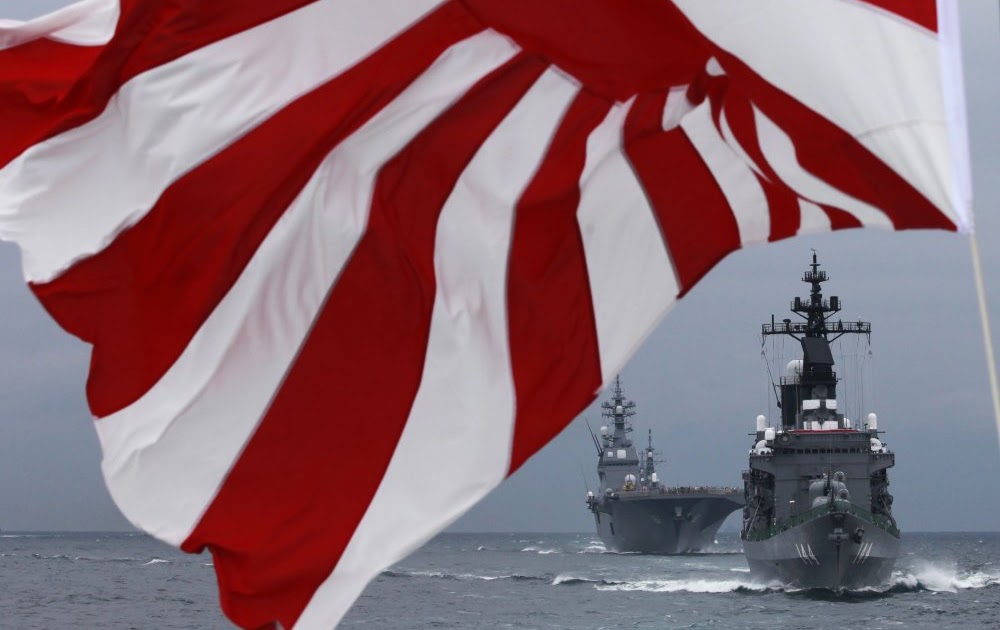
If They Name Them “Yamato” and “Musashi” I will Probably Stroke Out
We talked about them a little bit on yesterday's Midrats , but I can't keep them out of mind - so, we'll start out the week looking at one h...
I can't imagine these ships wouldn't have a self defense capability. If you already have Aegis and Mk41 tubes for the ABM mission, surely adding a few more cells to a 20,000 ton ship to provide some SM-2 or ESSMs would be pocket change.
Nuclear power is a non starter for political and practical reasons; you don't just throw a nuclear reactor design together in under five years regardless of how much experience you do or do not have.
Nuclear power is a non starter for political and practical reasons; you don't just throw a nuclear reactor design together in under five years regardless of how much experience you do or do not have.
AAW self defense is a given since there is already talk about submarine defense and Type 12 advanced. I have seen talk about A-SAM being used in place of SM-2. A-SAM being the Type 03 Kai with a booster for naval use. It would be interesting if XRIM-4 would be revived for this as well since it seems to be getting all the prime weapons the JMSDF has to offer.I can't imagine these ships wouldn't have a self defense capability. If you already have Aegis and Mk41 tubes for the ABM mission, surely adding a few more cells to a 20,000 ton ship to provide some SM-2 or ESSMs would be pocket change.
Nuclear power is a non starter for political and practical reasons; you don't just throw a nuclear reactor design together in under five years regardless of how much experience you do or do not have.
- Joined
- 16 April 2008
- Messages
- 9,616
- Reaction score
- 14,524
Looks like a major rethink underway to recast these ships as 8000-ton DDGs. Could end up as essentially repeat Maya class with SPY-7 vice SPY-1.
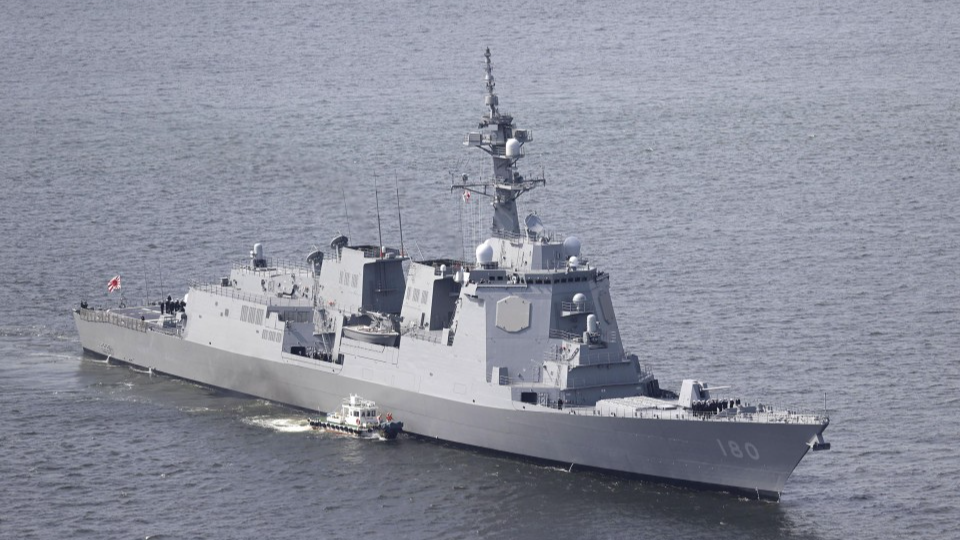
 english.kyodonews.net
english.kyodonews.net

Japan to downsize 2 planned Aegis destroyers to increase mobility
Japan is considering downsizing two destroyers to be built with the Aegis ballistic missile interceptor system from their original design in a bid to increase their mobility, government sources said on Nov. 8.
A bit of a shame, but the reasoning seems a little confusing. The deployment of Tomahawks doesn't really change much as they are pretty much a stopgap until Type 12 ASCMs could be deployed which these ships were already planning to mount. As far as speed, both the Hyuuga and Izumo hullforms are capable of 30kts, so it seems they were initially considering an LPD hull form like the rumors.Looks like a major rethink underway to recast these ships as 8000-ton DDGs. Could end up as essentially repeat Maya class with SPY-7 vice SPY-1.

Japan to downsize 2 planned Aegis destroyers to increase mobility
Japan is considering downsizing two destroyers to be built with the Aegis ballistic missile interceptor system from their original design in a bid to increase their mobility, government sources said on Nov. 8.english.kyodonews.net
The entire point of these 2 ships was a primary focus on BMD, which makes it weird that the JMSDF would not only reduce the number of potential VLS cells, but also further reduce the BMD capacity by using up cells with Tomahawks. With the 20000t idea they could have potentially 288 VLS cells. They could do a full Tico's worth of 122 of SM-3/6s and 122 Tomahawks and fills the remaining 44 with quad ESSMs. They could still reduce the number of VLS cells and not sacrifice any performance in other departments.
Since the crew still appears to be cut to 1/3 of a Burke compliment, I hope they use the extra space to at least reach the Tico's 122 VLS cells because maintaining the 96 of a normal Maya seems to be cutting into it's BMD capabilities.
- Joined
- 9 October 2009
- Messages
- 21,979
- Reaction score
- 13,647
One senses the dark hand of the Ministry of Finance behind this rather ill-advised downgrade...
- Joined
- 16 April 2008
- Messages
- 9,616
- Reaction score
- 14,524
One senses the dark hand of the Ministry of Finance behind this rather ill-advised downgrade...
Doesn't sound liek Japan is cutting expenditures in general.
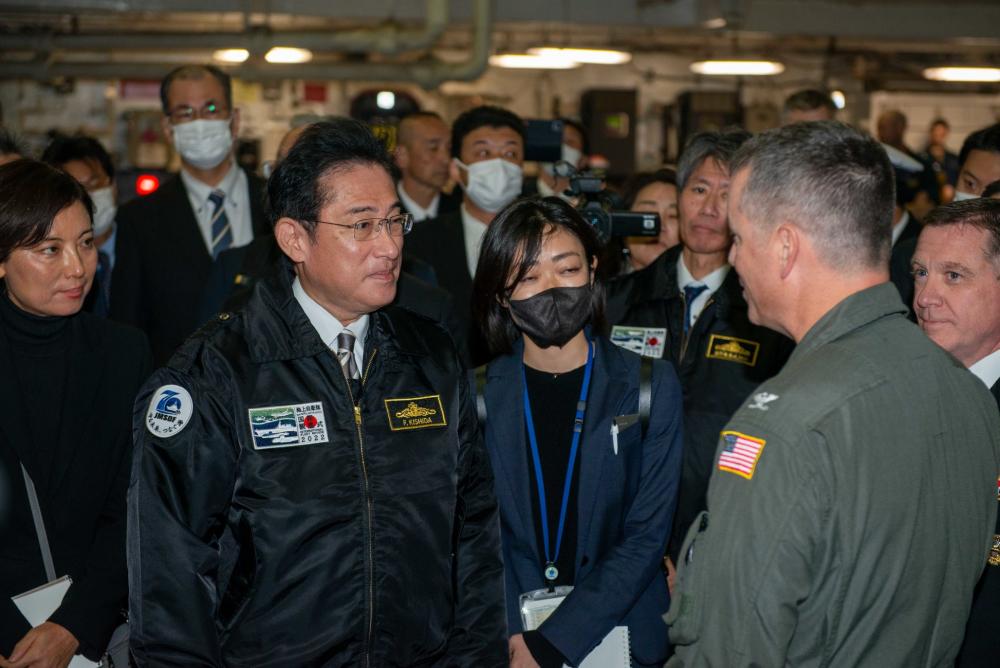
Japanese PM Kishida Renews Calls for Expanded Defense Spending - USNI News
Japan’s Prime Minister Fumio Kishida reiterated his country’s commitment to expanding Japan’s defense capabilities to deal with those who would jeopardize the peace and security of other countries, in a speech this week aboard destroyer helicopter carrier JS Izumo (DDH-183). “We must be prepared...
I wonder if it's more an issue of what can be done relatively soon. If it's a repeat Maya hull, even with new radars, that's one less development cycle than a clean sheet design.
To be honest with you, I'm pretty sure at this point that the problem with 20000t plan wasn't the cost.It seems we are planning to build something crazy.
According to Mr. Masahisa Sato, foreign affairs and defense committee chairman of the ruling LDP, SPY-7 equipped Aegis ship will feature full ASW, AAW, cruising at 30+ knot capability with more than 200 VLS.
View: https://twitter.com/SatoMasahisa/status/1604008952076722176
Ares
Man from Far East
- Joined
- 15 October 2018
- Messages
- 103
- Reaction score
- 457
To be honest with you, I'm pretty sure at this point that the problem with 20000t plan wasn't the cost.It seems we are planning to build something crazy.
According to Mr. Masahisa Sato, foreign affairs and defense committee chairman of the ruling LDP, SPY-7 equipped Aegis ship will feature full ASW, AAW, cruising at 30+ knot capability with more than 200 VLS.
View: https://twitter.com/SatoMasahisa/status/1604008952076722176
Yeah, I also thought they would adopt the Aegis Ashore on a cargo ship which is considered the cheapest solution, or at least an LPD-based BMD ship, and after the downsizing plan was announced, it would be additional derivative version of Maya Class.
But no, they really were seriously planning to build a Reiwa-era Yamato Class.
Last edited:
US Navy stated that radar sensitivity scales as a cube of the size of the radar aperture, and while improvements can be made to the T/R modules said this is a linear not cubic relationship and only adds marginal capability on the order of +1 or 2 dB.
Any indication what the size of the SPY-7 arrays will be on the new ~20,000t cruiser, the ~ 10,000t Burke Flt III SPY-6 has four arrays each of 148 sq ft (2'x2' x 37 RMAs) and Raytheon claim SPY-6 sensitivity 100 times better than the old gen SPY-1D(V)
Speculation if the Japanese cruiser arrays double Burkes in size looking at ~ eight times the sensitivity of Burkes SPY-6, if arrays triple Burkes the sensititivity would jump to twenty seven times?
Any indication what the size of the SPY-7 arrays will be on the new ~20,000t cruiser, the ~ 10,000t Burke Flt III SPY-6 has four arrays each of 148 sq ft (2'x2' x 37 RMAs) and Raytheon claim SPY-6 sensitivity 100 times better than the old gen SPY-1D(V)
Speculation if the Japanese cruiser arrays double Burkes in size looking at ~ eight times the sensitivity of Burkes SPY-6, if arrays triple Burkes the sensititivity would jump to twenty seven times?
- Joined
- 11 February 2010
- Messages
- 1,650
- Reaction score
- 2,707
hmm in my speculation such array compared to 37 RMA AMDR in current Arleigh Burke would offer 9dB of sensitivity improvement, if the array does triple the size, it would offer 14.3 dB increase over the 37 RMA array.
It would offer enormous range (11000 km for double sized and 15000 km for triple sized array) and clearly if suitable interceptor is available it can engage 7 km class target which correspond to ICBM's.
It would offer enormous range (11000 km for double sized and 15000 km for triple sized array) and clearly if suitable interceptor is available it can engage 7 km class target which correspond to ICBM's.
ICBM warheads a very challenging target as will be mixed in with accompanying decoys and debris of nosecones etc the radar needs to be able to distinguish the nuclear warheads so you don't waste two of your limited number ~$30 million SM-3 IIA's missiles seduced into targeting the decoys/nosecone, for that very reason the new Alaskan MDA/Lockheed LRDR has two massive 3,600 sq ft arrays to give the necessary needed resolution (same tech used as the SPY-7, Lockheed a proponent of dual polarization for its better resolution with their SPY-7s). Would think radar with only 7 m resolution would be marginal in ability to target the Chinese/North Korean ballistic missiles nuclear warheads, perhaps what's driving the Japanese for larger ship with larger arrays.hmm in my speculation such array compared to 37 RMA AMDR in current Arleigh Burke would offer 9dB of sensitivity improvement, if the array does triple the size, it would offer 14.3 dB increase over the 37 RMA array.
It would offer enormous range (11000 km for double sized and 15000 km for triple sized array) and clearly if suitable interceptor is available it can engage 7 km class target which correspond to ICBM's.
Ares
Man from Far East
- Joined
- 15 October 2018
- Messages
- 103
- Reaction score
- 457
Feast thy eyes.
The only one of its kind, Aegis Arsenal Ship(not the final configuration)
Seriously, what the fuck is going on?
https://www.mod.go.jp/j/yosan/yosan_gaiyo/2023/yosan_20221223.pdf
page.15

The only one of its kind, Aegis Arsenal Ship(not the final configuration)
Seriously, what the fuck is going on?
https://www.mod.go.jp/j/yosan/yosan_gaiyo/2023/yosan_20221223.pdf
page.15
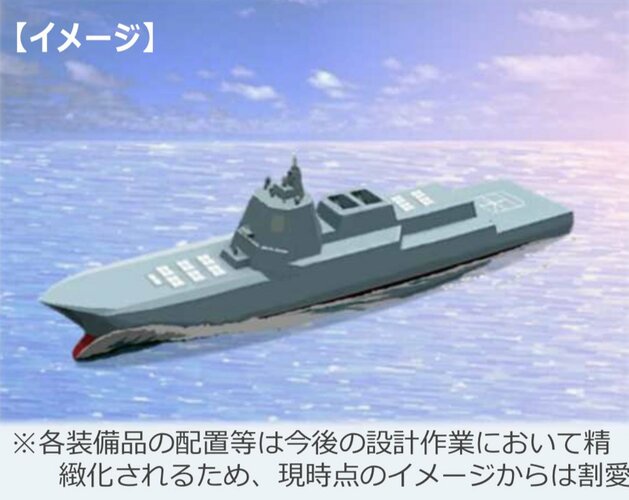
- Joined
- 16 April 2008
- Messages
- 9,616
- Reaction score
- 14,524
Feast thy eyes.
The only one of its kind, Aegis Arsenal Ship(not the final configuration)
Seriously, what the fuck is going on?
https://www.mod.go.jp/j/yosan/yosan_gaiyo/2023/yosan_20221223.pdf
page.15
View attachment 689984
I got nothing...
I mean, it's crude but not utterly implausible. But it sure seems like there's some serious fighting happening inside the JMSDF about that the heck ship they want to build, and what its purpose is.
Ares
Man from Far East
- Joined
- 15 October 2018
- Messages
- 103
- Reaction score
- 457
I got nothing...
I mean, it's crude but not utterly implausible. But it sure seems like there's some serious fighting happening inside the JMSDF about that the heck ship they want to build, and what its purpose is.
Actually, that fight is already over at this point and this draft represents a solid set concept of the ship that has been vague for years.
They will build an arsenal cruiser with 300+ VLS.
- Joined
- 4 July 2010
- Messages
- 2,516
- Reaction score
- 3,100
What's the Japanese equivalent phrase to "heckin chonker" these days?Feast thy eyes.
The only one of its kind, Aegis Arsenal Ship(not the final configuration)
Seriously, what the fuck is going on?
https://www.mod.go.jp/j/yosan/yosan_gaiyo/2023/yosan_20221223.pdf
page.15
View attachment 689984
Ares
Man from Far East
- Joined
- 15 October 2018
- Messages
- 103
- Reaction score
- 457
What's the Japanese equivalent phrase to "heckin chonker" these days?Feast thy eyes.
The only one of its kind, Aegis Arsenal Ship(not the final configuration)
Seriously, what the fuck is going on?
https://www.mod.go.jp/j/yosan/yosan_gaiyo/2023/yosan_20221223.pdf
page.15
View attachment 689984
Had to check what is Heckin Chonker means. The closest one that I can think of is デカ尻ババア
Don't google it though.
- Joined
- 4 July 2010
- Messages
- 2,516
- Reaction score
- 3,100
Perenially good adviceWhat's the Japanese equivalent phrase to "heckin chonker" these days?Feast thy eyes.
The only one of its kind, Aegis Arsenal Ship(not the final configuration)
Seriously, what the fuck is going on?
https://www.mod.go.jp/j/yosan/yosan_gaiyo/2023/yosan_20221223.pdf
page.15
View attachment 689984
Had to check what is Heckin Chonker means. The closest one that I can think of is デカ尻ババア
Don't google it though.
Forest Green
ACCESS: Above Top Secret
- Joined
- 11 June 2019
- Messages
- 9,544
- Reaction score
- 17,527
690ft (210m) long and 130ft (40m) beam. This is definitely more missile cruiser than destroyer.


Forest Green
ACCESS: Above Top Secret
- Joined
- 11 June 2019
- Messages
- 9,544
- Reaction score
- 17,527
If each little rectangle is a block of 8, I count 336 cells.Actually, that fight is already over at this point and this draft represents a solid set concept of the ship that has been vague for years.
They will build an arsenal cruiser with 300+ VLS.
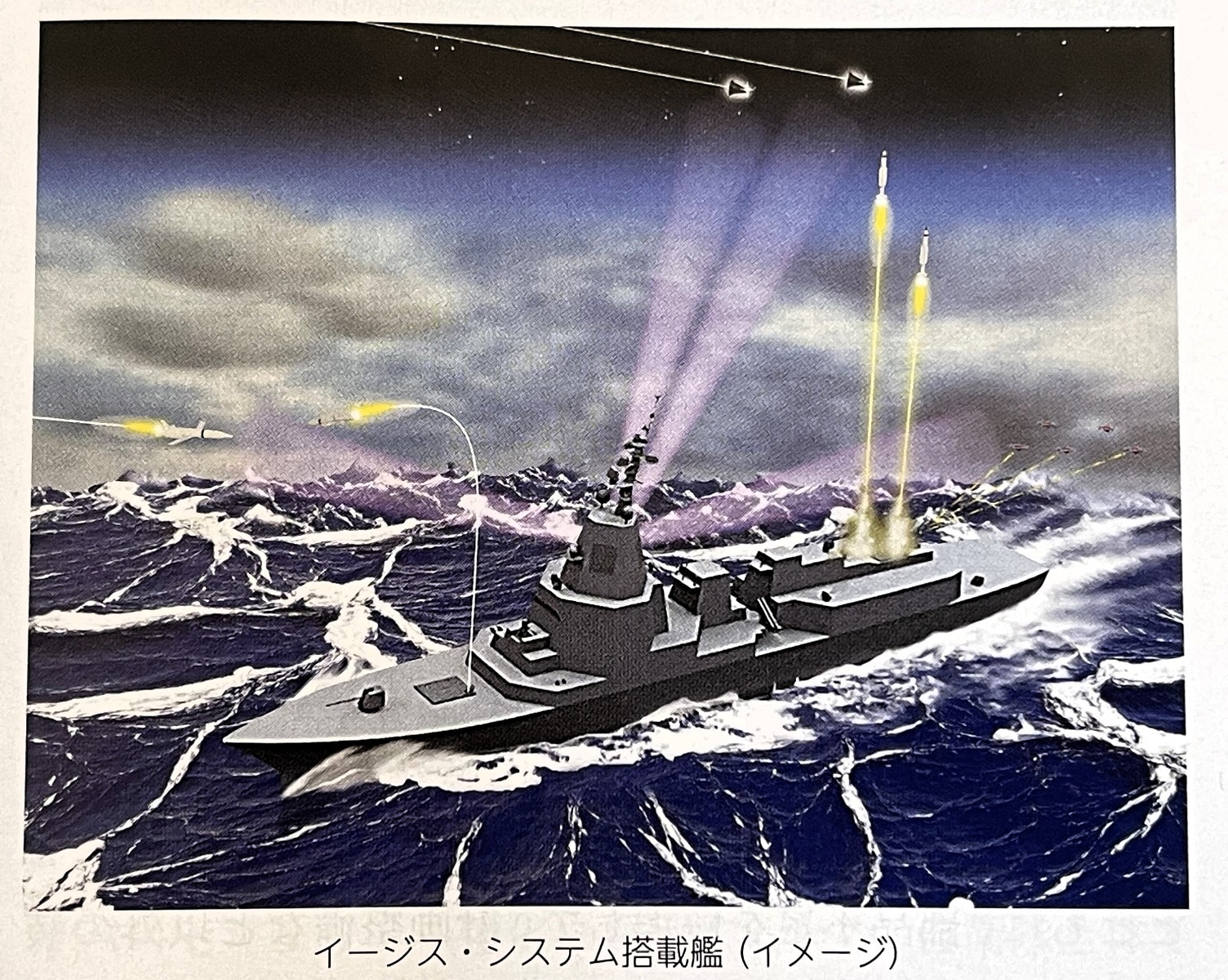
Japan's MoD Unveils New Image of ASEV - Naval News
The Japanese Ministry of Defense has unveiled a new image of the Aegis system equipped vessel (ASEV) for the JMSDF.
Attachments
Ainen
I really should change my personal text
- Joined
- 25 August 2011
- Messages
- 1,296
- Reaction score
- 1,744
Gotta say, 5" pee shooter on a ship this big looks boring.
- Joined
- 16 April 2008
- Messages
- 9,616
- Reaction score
- 14,524
Gotta say, 5" pee shooter on a ship this big looks boring.
And kinda pointless. I'd give it a couple of 76mm instead.
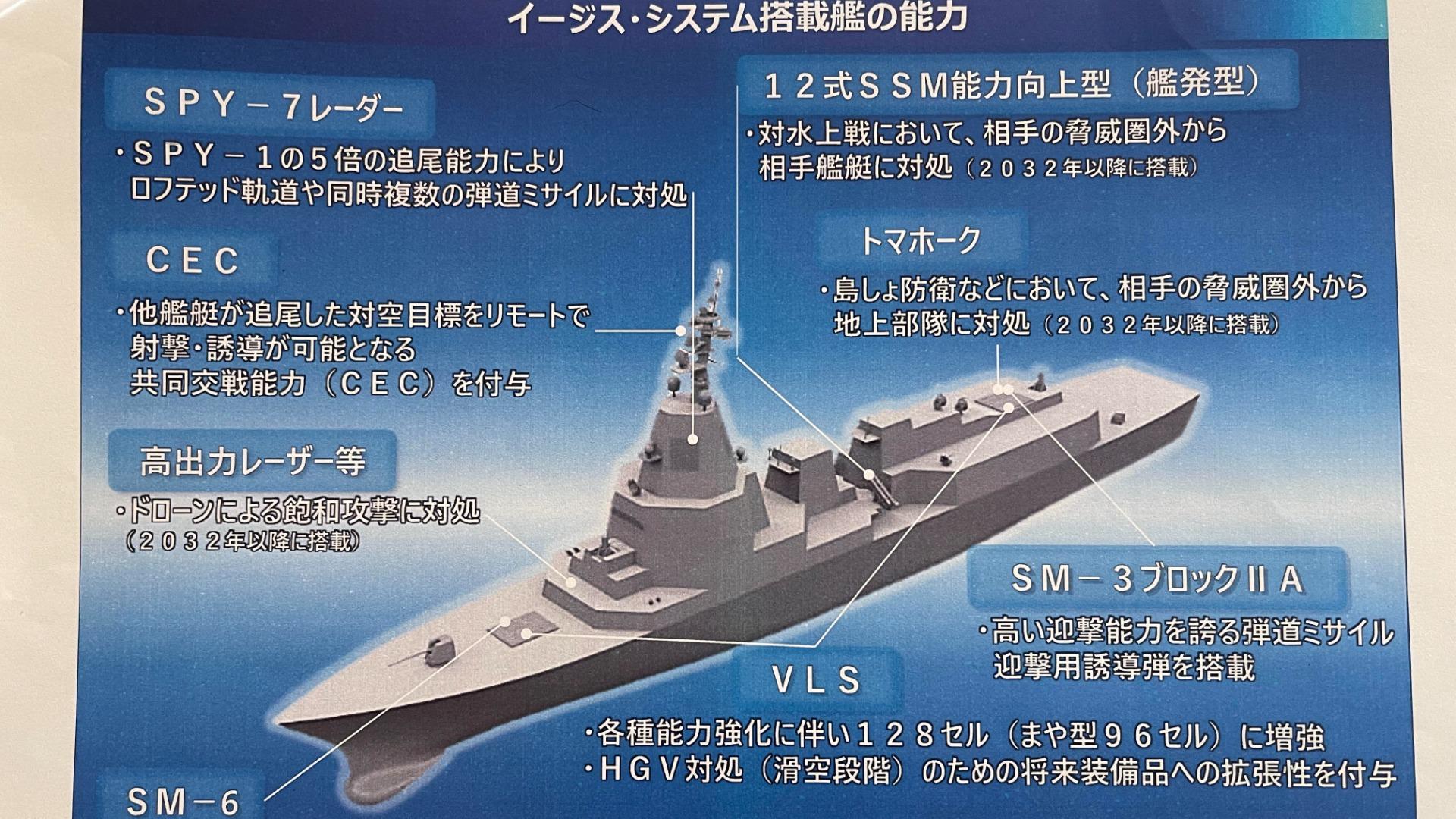
海自新型FFMは12隻を建造へ 2024年度防衛予算概算要求の主な注目点(高橋浩祐) - エキスパート - Yahoo!ニュース
防衛省は8月31日、過去最大の7兆7385億円に及ぶ2024年度防衛予算の概算要求を決定した。年末の予算編成で正式に予算案が決まる予定だ。主な注目点をまとめた。●海上自衛隊「新型FFM」2隻の建造に1
Length: ~190m
beam: ~25m
Standard displacement:~12000t
Crew:240
Attachments
Similar threads
-
-
-
-
-
JMSDF - CVH Next (Izumo Class Follow-on)
- Started by Ironmiked
- Replies: 2

